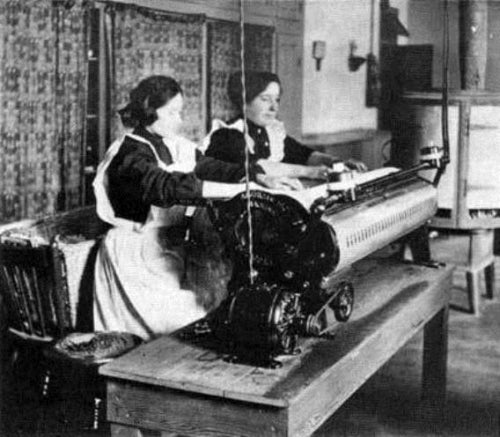Uncategorized
1916: The Advocate

 |
|
Teamsters were called the “Vaseline club” because they used Vaseline to protect horses from the halters. Tobin Is the 10th from left, bottom row (Tom Hughes is 5th from left). |
Tobin’s vision for the future of the union and his goals for improving the lives of members helped push the Teamsters to the forefront on every major issue in the 20th century and made the union a leader in the labor movement.
As editor of the International Teamster, Tobin wrote a monthly editorial to promote issues he found personally important to the labor movement. With social freedoms emerging and more women started entering the workplace, Tobin began using the column to push for equality within the union.
Building the Sisterhood
Tobin recognized the value of organizing women as a way to strengthen the union’s voice and increase membership; and, consequently, he used the magazine to lead the charge for women’s rights within the workplace, writing in 1917 that: “Equal pay for equal work should become a constant, vigorous slogan among all employees in all crafts. The strength and brains of women and girls are exploited the world over and especially so in the United States. All working men and women should become actively, and, if necessary, drastically interested in fighting for equal pay for duties performed by either sex.”
Concerned that unscrupulous employers would view these workers as easy targets, Tobin set out to bring union protection to working women across the country. With the aid of John Gillespie, organizing efforts were increased and Teamster women were given additional training in bargaining tactics. In 1916, Tobin established the first all-female negotiating committee from laundry workers in Chicago. Following their success at the bargaining table, the door was opened to organize more “auxiliary members” in the laundry, food, and other related industries.
“Teamsters Know No Color Line”
In addition to gender equality, Tobin pushed for racial equality. He was adamant that the contract for the female laundry workers in Chicago include a non-negotiable provision that black women must be paid equally to white women. Writing about the win for equal rights in the International Teamster that year, Tobin boasted that “Teamsters know no color line.” The union was on its way to becoming one of the most diverse organizations in the country.
 |
|
Two African-American teamsters clear ground for a tank farm at Magnolia Petroleum Company |
In the coming years, Tobin would continue to promote racial and gender equality within the union. He took great pride in knowing that the Teamsters had no segregated union halls and put pressure on employers to hire black men and women of all races. When Tobin later received death threats for his advocacy for civil rights, he quipped, “They can only kill you once, so it might as well be for something good!”
Thunder and Lightning
Tobin’s belief in workers’ rights would lead to a belief in animal rights. Before becoming General President, Tobin was a member of the “Vaseline club”—a group of animal activists within the Teamsters who promoted the working conditions of team horses. (The name comes from the Vaseline used to protect the horses from the haters.) Tobin wrote frequently on the topic of the horses, including one article titled, “What The Horse Would Say,” written from the perspective of a working Teamster horse.
By 1916, technological progress began to affect the Teamsters at their very heart. Horses—their faithful partners—were being outmoded with the advent of the motorized truck. It would be years before horses were completely retired, but Tobin had the foresight to remember their legacy. At the 1916 Convention, delegates voted overwhelmingly that the horse must officially always be a part of the Teamster logo.
Also in 1916
 |
|
United Parcel Service (UPS) founder James Casey asks the Teamsters to organize his workers. |
James Casey came to the Teamsters, asking the union’s West Coast locals to organize drivers at Merchants Delivery Service (renamed United Parcel Service in 1919). Together, Tobin and Casey would form the most successful partners in the history of labor-business relations. Casey admired Tobin’s leadership and believed in the cause of the Teamsters Union. The two remained in contact with one another until Tobin’s death in 1952. Casey was inducted in 2002 as a member of the U.S. Department of Labor a Hall of Fame.